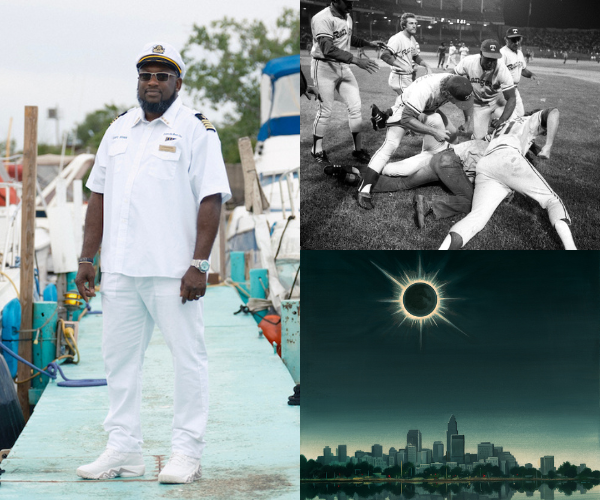The Happiest of Days
by Michael D. Roberts | Dec. 27, 2007 | 5:00 AM
I graduated from Garfield Heights High School with 228 others on June 6, 1957. U.S. News and World Report recently celebrated that year as one of the 20th century’s most significant, the dawn of the Space Age and the civil rights movement. It didn’t seem that way the night we graduated.
At the reunion, where 100 returned, we agreed our timing was perfect: We’d escaped the Depression and three wars. The ill-fated Edsel was born that year, the Eisenhower Administration seemed to be made of stern gray men in gray suits, and the Cold War hung over us in the specter of a mushroom cloud. There was no color television, and gasoline was 24 cents a gallon.
We were naïve then. To us, diversity meant a choice of pizza toppings. There were no black students in our class. I’m told that we had one Jewish boy, who transferred from the Hough area. Prejudice was only something we read about taking place in the South. There were no drugs, and only those on the edge drank beer. Smoking in the lavatories was considered a high crime.
Amazingly, we were all from the same basic social class. Our families had no money, and our blue-collar neighbors helped each other with house painting, plumbing and auto repair. The social playing field was so level, there was no horizon.
The 12 years we spent together is no small amount of time when you consider the span of a life. The former Linda Rosa, who sat behind me for the duration, recognized me at the reunion from the back of my head.
Mostly, though, recognition was the hardest part of the weekend. Time morphs the features, and most of us had gone to gray and girth, so we squinted at the name tags and looked up with surprise when before us stood a long-ago pal.
Since we’d had little in common in the last 50 years, our bond was 1957. We were all trapped in that out-of-body experience, yet somehow, the high school pecking order of cliques — jocks, greasers, nerds, the hip — didn’t rule.
The reunion was a blur of faces and revelations. There was Bobby Mantel, who spent a career in the U.S. State Department, serving in the White House in Lyndon Johnson’s days. Commodore Don Hudak entertained the class at his yacht club, something that in 1957, many of us could not spell, let alone attend.
Peggy Major McCafferty, the homecoming queen, was as gracious as ever, and the former Hazel Wiggins hugged me and said that I still did not smile enough. Kenny Metti spoke of an improbable basketball scrimmage against a great and graceful East Tech team that made it painfully clear that slow and short was synonymous with white.
Across the room, I saw Ray Maria, the basketball captain, talking to a cheerleader. When he came over to me, I asked what they’d talked about. With one of those cynical grins, full of mischief and go-to-hell, he looked at me and said: “She blew me off, just like she did 50 years ago.”
One classmate had won the lottery: $20 million. He said it cost him more trouble than it was worth with friends and family, all of whom felt some entitlement to the treasure. I think it better not to mention his name, to avoid the brokers, insurance salesmen and real estate agents who besiege him in swarms. He said all he likes to do now is fish.
Cliff Foust, now 84, coached the football team in 1957. A legendary figure in Greater Cleveland high school athletics, Foust joined us and remembered the players by position, a memory that warmed the hearts of his former Bulldogs. There was debate over which game the now Dr. James Schieda had been ejected from: against Shaker Heights or University School?
“I think he got thrown out of both of them,” I said, trying to curtail the embarrassment of a collective senior moment.
Across the way, I saw Douglas Swiderski. I owed him a lot. Swiderski ended my football aspirations one afternoon during practice. I tackled him so hard that my teeth rattled like dice, and then he asked me if I was really trying. I made a career decision that moment: It was better to write about certain things than do them.
Out of the class of 229, we knew of at least 41 dead. The first to die killed himself over a girl shortly after graduation. Another disappeared from a bar in Playhouse Square sometime in the late ’60s. A former FBI agent in the class said he thought it was over a hot jewelry deal that went sour.
There was a girl in our class who was quiet, demure and smart. She lived with her mother off of Garfield Boulevard, and in grade school I’d walk home with her. In high school, I remember her as a vague figure, removed from us, always near the top of her class, but never for revelry. The girl, Allene Leonards, became a schoolteacher. We thought her destined for an uneventful life.
Then, in 1963, the colorful Shondor Birns — long considered Cleveland’s Public Enemy No. 1 — was sought in the killing of a man named Mervin Gold. Mr. Gold made off with bonds belonging to associates of Mr. Birns — not a wise decision.
The hunt for Shondor Birns was a big story. Headlines screamed evil. Pictures showed his surrender. After 30 years of crime, it appeared that Shondor was in the deepest trouble he had ever been.
Shy, studious Allene Leonards was Shondor’s alibi. She told police she was with him the night of the murder. They never really believed her, but couldn’t prove otherwise. Later, she became Mrs. Birns.
Shondor was killed by a car bomb in 1975. The equally infamous and explosive Danny Greene was thought to be the bomber. Over the years, I tried to reach Allene for her story through intermediaries (mainly bartenders), but she always politely declined. She died a few years ago. She would have liked knowing that we remembered her at the reunion and spoke of how her intelligence ruined the grade curve for those of us who were less enthusiastic students. She was smart enough to beat the cops.
Not everyone came to the reunion. For some, high school was a painful time that left indelible memories of embarrassment, rejection and remoteness.
A few weeks beforehand, I ran into a fellow I probably hadn’t seen since graduation. I was happy to see him. He was one of the funniest guys in the class. He once went to his wife’s reunion and left after they failed to recognize anyone. Later they learned they were at the wrong reunion.
“You coming Saturday?” I shouted across a parking lot.
“No, man,” he said. “There is not a lot that I want to remember about it, and very few people I want to see.”
It saddened me. I knew that many others wanted to see him. High school was funny that way.
The former Judith Hepplewhite, my first formal date, had been expected, and I was disappointed when she did not appear. I e-mailed her my regret, even though we had not spoken in 36 years.
She responded in the same cerebral fashion I remembered. Mentioning Zen and existentialism, she said she had vacillated over coming, wondering whether one can go home again.
The last time she was in Cleveland, she said, her cousin’s son unleashed his pet python into her bedroom at 3 a.m. She left for Tennessee the next day and never came back. Over the years, she has fought a forest fire, panned for gold and lived in a fishing camp. She wasn’t a bad date either.
The reunion ended on Sunday with a brunch. After three days together, the strength of our bond surprised us. With the festivities drawing to a close, we felt a sense of melancholy.
Across from me was the former Carol Hazen, a cheerleader who played the cymbals in the band. We called her Ching, after the sound her cymbals made: ta-a-ta-da ... boom ... ching!
“You know,” she said as we finished our coffee, “we probably won’t ever see each other again.”
I thought about that for a moment. I didn’t say it, but I should have: Ching was right, but the fact that we’d gotten the chance to grow up together in such tranquility was far more important than the poignancy of finality.
A famous writer once said that, carried to the conclusion, all stories end sadly. That may be true, but can it be that the journey is more meaningful than the ending?
Trending
-
1
-
2
-
3
-
4
-
5










